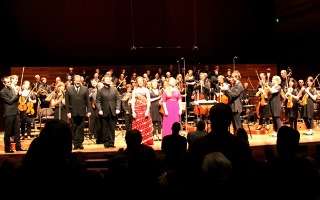|
Back
Beethoven 9, Ode to Joy Melbourne
Hamer Hall
08/04/2012 - & August 5, 6, 7, 8, 9, 10, 11, 12*, 13, 14, 15, 2012
Olivier Messiaen: L’Ascension: «Prayer of Christ ascending towards his Father»
Johannes Brahms: Geistliches Lied, opus 30
Ludwig van Beethoven: Calm Sea and Prosperous Voyage, opus 112 – Symphony No.9 in D minor, opus 125
Lucy Crowe (Soprano), Fiona Campbell (Mezzo-soprano), Allan Clayton (Tenor), Matthew Brook (Bass-Baritone)
Choir of Clare College, Cambridge, Graham Ross (Director), The Australian Chamber Orchestra, Richard Tognetti (Artistic Director and Lead Violin)

(© G. P.)
In Melbourne’s beautifully refurbished Hamer Hall, a capacity audience were today treated to a superb rendition of the grand Beethoven 9th symphony but one which differed from expectations. Frequently, we associate this work with the immensity of certain European orchestras and fall into the ready expectation that all performances will replicate this formula. The ranks of the Australian Chamber Orchestra were swelled to fifty players, many fewer than might have been expected for a performance of this massive work. Lead as always by Richard Tognetti from his 1743 Guarneri del Gesù violin, the band of many period instruments provided a particularly thrilling interpretation and one which we might expect to more closely resemble the original performances that the immensity which is often associated with this masterwork.
The audience were lead gently into the Beethoven through the ethereally beautiful «Prayer of Christ ascending towards his father» from L’Ascension by Messiaen. Wave-like rhythms and mesmerising swells from the strings of the Australian Chamber Orchestra captured the monochromatic intentions of the composer. The tempo intensely slow and thoughtful and the hush of quiet expectation it produced in the listeners was a perfect lead into the later pieces.
The first Beethoven piece Calm Sea and Prosperous Voyage from his middle period introduced us to the exquisitely honed skills of the Choir of Clare College, Cambridge. This band of young performers is touring with the ACO this season and is preceded by a justifiably high profile and even higher expectations. With the orchestra, they took Beethoven’s smooth and melancholy chant and gave it a life of rich harmonies and brilliantly executed diction. It is a calming and gentle piece which reflects the power of the sea juxtaposed against the rising hopes of the sailor. The combination of the choir and orchestra gave the audience a taste of contrasts; of threats of violence and glassy doldrums-calm. All these sensations were to serve well for the delivery of the massive Ninth after the interval.
In the Ninth Symphony, Tognetti and the orchestra played the opening Allegro with energy and vitality. They lead us into expectations and offered promises of an immense struggle of ideas. Tognetti offers glimpses of the grandeur of the finale but teases the audience with carefully modulated renderings in this and the second movement. The melodies were fragile and the many period instruments in the orchestra emphasised the sense of hearing the symphony as it may have been originally performed. Many of the winds and brass are copies of classical instruments and the “natural” horns and bassoon lent a level of authenticity to this performance. Overall, there is a sense on the ‘period’ instruments that the piece has an antique fragility about it and transient vitality unable to be achieved on modern instruments.
The Choir were the highlight of the symphony. They have a youthful voice and vigour of presentation which brought a brightness and newness to the familiar choral movement. Strong individual sections ranged from distant and floating in some passages to authoritative and demanding of attention in others. The men in particular offered a hugely substantive range; more than just an under-current but a dominant and driving force to match the parts given by Beethoven to his solo male singers. Lucy Crowe’s soprano rang bell-like over the players and singers, while Fiona Campbell provided strength and richness of tone in the Mezzo part.
The baritone solo was delivered by Matthew Brook with ease and joviality. He addressed the audience as friends singing of joy and brotherhood. His tenor counterpart Allan Clayton delivered his solo with a similar strength and vivacity but it was the chorus calling us all to be embraced and rejoice in the joy which drew the listeners into the performance.
An enraptured audience rewarded the orchestra, choir and soloists with a standing ovation and drew the principals back repeatedly for acclaim. It was an invigorating concert and on reflection, one which gave a variety of interpretations to the familiar music and a depth of sentiment arguably unachievable within the confines of the usual enormous orchestra and vast choir. There was a fragility and ephemeral aspect to this performance that matched perfectly the joyous sentiment of the Ninth. Young voices, confident and energetic demanded to be heard and presented an undeniably attractive departure from the formality and grandeur associate with this work.
Gregory Pritchard
|